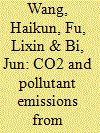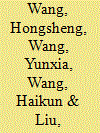|
|
|
Sort Order |
|
|
|
Items / Page
|
|
|
|
|
|
|
| Srl | Item |
| 1 |
ID:
109321


|
|
|
|
|
| Publication |
2011.
|
| Summary/Abstract |
The development of urbanization is accelerating in China, and there are great pressures and opportunities in cities to reduce carbon emissions. An emissions inventory is a basic requirement for analyzing emissions of greenhouse gases (GHGs), their potential reduction and to realize low-carbon development of cities. This study describes a method to establish a GHGs emissions inventory in Chinese cities for 6 emission sources including industrial energy consumption, transportation, household energy consumption, commercial energy consumption, industrial processes and waste. Nanjing city was selected as a representative case to analyze the characteristics of carbon emissions in Chinese cities. The results show that carbon emissions in Nanjing have increased nearly 50% during the last decade. The three largest GHGs contributors were industrial energy consumption, industrial processes and transportation, which contributed 37-44%, 35-40% and 6-10%, respectively, to the total GHGs emissions. Per GDP carbon emissions decreased by 55% from 2002 to 2009, and the per capita and per GDP carbon emissions were comparable or even lower than the world average levels. These results have important policy implications for Chinese cities to control their carbon emissions.
|
|
|
|
|
|
|
|
|
|
|
|
|
|
|
|
| 2 |
ID:
104983


|
|
|
|
|
| Publication |
2011.
|
| Summary/Abstract |
In this paper, CO2 and pollutant emissions of PCs in China from 2000 to 2005 were calculated based on a literature review and measured data. The future trends of PC emissions were also projected under three scenarios to explore the reduction potential of possible policy measures. Estimated baseline emissions of CO, HC, NOx, PM10 and CO2 were respectively 3.16×106, 5.14×105, 3.56×105, 0.83×104 and 9.14×107 tons for China's PCs in 2005 with an uneven distribution among provinces. Under a no improvement (NI) scenario, PC emissions of CO, HC, NOx, PM10 and CO2 in 2020 are respectively estimated to be 4.5, 2.5, 2.5, 7.9 and 8.0 times that of 2005. However, emissions other than CO2 from PCs are estimated to decrease nearly 70% by 2020 compared to NI scenario mainly due to technological improvement linked to the vehicle emissions standards under a recent policy (RP) scenario. Fuel economy (FE) enhancement and the penetration of advanced propulsion/fuel systems could be co-benefit measures to control CO2 and pollutant emissions for the mid and long terms. Significant variations were found in PC emission inventories between different studies primarily due to uncertainties in activity levels and/or emission factors (EF).
|
|
|
|
|
|
|
|
|
|
|
|
|
|
|
|
| 3 |
ID:
133243


|
|
|
|
|
| Publication |
2014.
|
| Summary/Abstract |
Knowledge of the factors driving greenhouse gas (GHG) emissions from cities is crucial to mitigating China's anthropogenic emissions. In this paper, the main drivers increasing GHG emissions from the Chinese city of Suzhou between 2005 and 2010 were identified and quantitatively analyzed using the Kaya identity and the log-mean Divisia index method. We found that economy and population were the major drivers of GHG emissions in Suzhou, having contributed 162.20% and 109.04%, respectively, to the increase in emissions. A decline in carbon intensity, which was caused by the declining energy intensity and an adjustment to the mixture of power and industrial structures, was the major determinant and accounted for a reduction of 171.24% in GHG emissions. Slowing and maintaining healthy growth rates of economy and population could be the primary and most effective means if Suzhou tries to curb the total emissions over the short term. It may be more realistic for Suzhou to control emissions by optimizing the economic structure for low-carbon industrial development because of the city's relative high energy requirements and low potential to mitigate GHGs by adjusting the energy mixture.
|
|
|
|
|
|
|
|
|
|
|
|
|
|
|
|
|
|
|
|
|